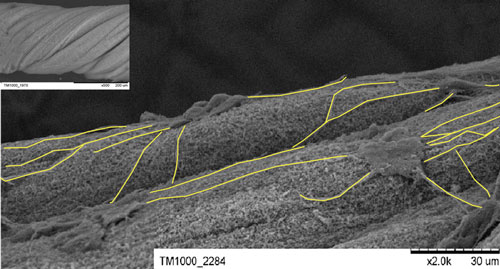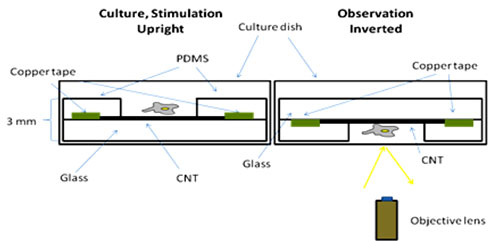| Posted: Jul 23, 2012 | |
Carbon nanotube rope stimulates neural stem cells |
|
| (Nanowerk Spotlight) Carbon nanotubes, like the nervous cells of our brain, are excellent electrical signal conductors and can form intimate mechanical contacts with cellular membranes, thereby establishing a functional link to neuronal structures. There is a growing body of research on using nanomaterials in neural engineering (see our previous Nanowerk Spotlight: "Exploring the complexity of nanomaterial-neural interfaces"). | |
| This emerging field of 'nanoneuroscience' explores and utilizes the potential of carbon nanotubes (CNTs) for fabricating durable, robust substrates, scaffolds and interfacing devices that change how researchers approach neuroscience. One area of neuron-CNT interaction that is now being probed is the effect of CNTs on neural stem cells. | |
| In new work by a team of scientists from Taiwan, it was found that electrical stimulation significantly promotes the early differentiation and maturation of neural stem cells (NSCs). | |
 |
|
| SEM image of the interaction of NSCs on CNT rope. The majority of neurites extend along the ridgelike structure of the spiral topography. Inset: low-magnification image of the CNT rope structure. (Reprinted with permission from Wiley-VCH Verlag) | |
| Reporting their work in the July 2, 2012 online edition of Small ("Carbon Nanotube Rope with Electrical Stimulation Promotes the Differentiation and Maturity of Neural Stem Cells"), a team led by Tzu-Wei Wang, an assistant professor in the Department of Materials Science and Engineering at National Tsing Hua University, found that neural stem cells plated on carbon nanotube rope were not only boosted towards differentiated neurons but also promoted their neurite elongation when compared to conventional tissue culture plate via the analysis of neuronal specific gene and protein expressions. | |
| "The CNTs used in our study are in the form of neither catalyst pattern, film composite or dispersed solution but rather in a free standing form of CNT," Wang explains to Nanowerk. "Unlike composite and spray coated films, this form of CNT does not need any additional additives when being synthesized, thereby eliminating the concern of the additives' cytotoxicity. Besides, it is solely composed of CNT with fully free standing CNT structure. The free standing nature allows us to operate the collected bulk CNT into desirable sizes and shapes without the limitation of substrates." | |
| The researchers created an independent CNT rope, which serves as an implantable substrate for neural stem cell growth while also having the ability to provide electrical stimulation through the CNT rope interface with in situ observation capability. | |
| These NSCs were fluorescently transfected and cultured on the CNT twisted rope-like structure. This CNT rope device provides a platform for the possibility to in situ observe the real-time response of these stem cells on an eletroconductive substrate after electrical stimulation. | |
| Wang points out that the CNT rope allows the observation of living stem cell behavior. "For future applications, this is advantageous for investigating cell-cell or cell-matrix interactions in living cell conditions, thus providing a useful tool for cutting-edge research in nanomedicine" he says. | |
| The team is also interested in figuring out if nanotopography and nanostructure on CNT rope can have a guiding effect on the neurite outgrowth direction and even the influence of NSC phenotype. | |
 |
|
| CNT rope stimulation device. This schematic drawing side view of the CNT rope stimulation device shows how the device is used for NSC culture and in situ fluorescence observations. (Image: Dr. Wang, National Tsing Hua University) | |
| According to Wang, an electroconductive CNT rope substrate along with microelectrical stimulation may have a synergistic effect on promoting the healing process of damaged neural tissues. "Also, by monitoring the stem cells growth and differentiation on CNT rope substrate in real-time ex vivo condition may provide information of cellular behavior analysis on nanoscale dimension structure in more detailed molecular level such as signal transduction pathway and intracellular delivery of specific biomolecules& he points out. | |
| Furthermore, this CNT rope may serve as a neural prosthesis for the in vitro investigation of electrically stimulated therapeutic effect on neural degenerative disease or combine with neural stem/progenitor cells as an implantable construct for in vivo applications in neural engineering. | |
| Wang says that it still is a challenge to identify the optimal electrical stimulation parameters for maximizing the boosting effect of neurite outgrowth. "The incorporation of neurotrophic factors on CNT rope substrate may also be considered for proving biological cues to attract and facilitate regenerated neurites." | |
 By
Michael
Berger
– Michael is author of three books by the Royal Society of Chemistry:
Nano-Society: Pushing the Boundaries of Technology,
Nanotechnology: The Future is Tiny, and
Nanoengineering: The Skills and Tools Making Technology Invisible
Copyright ©
Nanowerk LLC
By
Michael
Berger
– Michael is author of three books by the Royal Society of Chemistry:
Nano-Society: Pushing the Boundaries of Technology,
Nanotechnology: The Future is Tiny, and
Nanoengineering: The Skills and Tools Making Technology Invisible
Copyright ©
Nanowerk LLC
|
|
|
Become a Spotlight guest author! Join our large and growing group of guest contributors. Have you just published a scientific paper or have other exciting developments to share with the nanotechnology community? Here is how to publish on nanowerk.com. |
|
